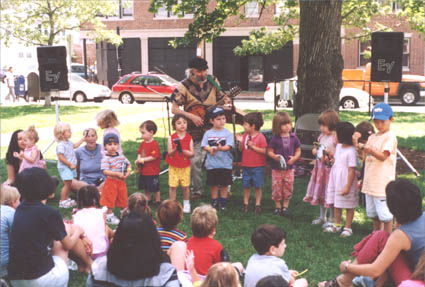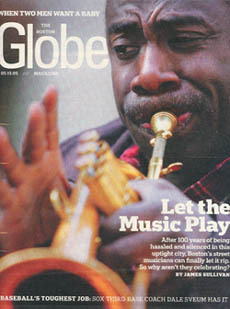A
sidewalk minstrel from Boston with over three decades of
performances, Stephen Baird, enchants young and old alike with
wonderful stories, poems, jokes, and plenty of songs. His
repertoire is seemingly endless, ranging from Irish ditties to
ragtime to sing-a longs. With leprechaun charm, he accompanies
himself on all manner of instruments; mandolin, banjo, dulcimer,
autoharp, kazoo, tambourine, and the fascinating limber jack - a
percussion instrument in the form of a wooden puppet toy. His
legendary "bag full of surprises" includes elephant, bumble bee
and tooth paste costumes to dress up the audience plus life size
puppets. Stephen Baird makes a place where people meet and touch
each other through art and music.
Stephen Baird, street singer, has toured
forty-eight states and Europe, playing on street corners, at
fairs, festivals, concerts, coffeehouses and over one hundred
college campuses since 1971. Instrumental in legalizing street
performing in Boston in 1973, he has since become nationally
renowned as an advocate of street performing. He has been featured
in Time, Newsweek, People, Nationa Law Journal, American Bar
Association Journal and many other magazines, a PBS-TV
documentary, and at the Kennedy Center for the Performing Arts in
Washington, D.C.
Stephen Baird restructured Club Passim, the historic folk music
venue in Cambridge, as a nonprofit organization in 1995-1997,
co-founded the Bread & Roses Festival in Lawrence in 1986,
founded the Folk Arts Network in 1982, published the New England
Folk Almanac and New England Folk Directory from 1982-1996,
produced Jamaica Plain Open Studios and was the Executive Director
of the Jamaica Plain Arts Council from 1999-2001. He is currently
the Executive Director of Community Arts Advocates.
From Ben Franklin to Tracy Chapman, Louis Armstrong to
the Violent Femmes, the streets of this country have been the
avenues of self expression for emerging artists and musicians.
Entire art forms such as tap dancing to break dancing, jazz to
blues, rock n' roll to rap singing have risen from the fusion of
diverse artists who have performed on the streets of New York
City, Boston, Chicago and New Orleans. The history of popular
culture has direct roots in the history of street performances.
Today the streets are still a dynamic stew of sounds and rhythms
from around the world.
The emancipation of the slaves after the Civil War resulted in
a flood of new artistic expression on the streets. The blues
migrated up the Mississippi from Memphis to Chicago. Jazz migrated
from Saint Louis to New Orleans. Eubie Blake performed on the
streets of Baltimore and New York City. The legendary Blind Lemon
Jefferson toured picnics and fairs from Texas to North Carolina.
For details see: Historical
References
Waves of immigrants from 1870 to the present day have found
their voices and audiences on the streets and subway platforms.
Irving Berlin and Eddie Cantor are the forebearers of the recent
multitude of artists arriving from Eastern Europe after the fall
of the Iron Curtain. Musicians from Central and South America can
be found on the streets of New York City, Boston, Seattle and San
Francisco filling the air with the lilt of pan pipes. For details
see: Historical
References
Contemporary jazz guitarist Stanley Jordan who developed the
"touch-technique-playing-style" performed on the streets of
Milwaukee and Madison, Wisconsin before moving on to the streets
of Boston and New York and greater recognition. Both Martin Sexton
and Tracy Chapman performed on the street corners of Cambridge's
Harvard Square, much like Joan Baez did three decades earlier.
Paul Simon and James Taylor plied the street of London with their
songs to earn cash for demo tapes.
For a deeper look at the opportunities and challenges for
street performers read Passing the Hat - Street Performers in
America (Delacorte Press) by Patricia J. Campbell and
Underground Harmonies - Music & Politics in the Subways of
New York (Cornell University Press) by Susie J. Tanenbaum.
See: Books
and References
Web sites to scan include <www.openair.org> (Street
Festivals, Street Vendors, Street Performers, Maxwell Street in
Chicago, etc), <www.flatworld.net> (Story on Santa Monica
legal battle), <www.performers.net> (Stories by Rex Boyd on
performing in Europe, plus David Cassel on performances in
Australia and tips on how to start out). These professional
vaudeville organization sites will lead to many individual site
links to noted street performers around the world
<www.juggling.org>, <www.magicians.org>,
<www.mimes.com>, <www.performingarts.net>. For hot
links and more details see: Links
and References
Boston was called the "Emerald City" of street performing by
Patricia Campbell. Artists can perform in Downtown Crossing,
Faneuil Hall Marketplace (Auditioned in March and scheduled
April-October), There is no permit currently required in Boston
(See this page for details on the 2004 Federal Court case:
Boston
Legal Battle 1972-2004. The MBTA issue permits for
$25. A picture ID is required. It is a first-come, first-serve
basis except for Harvard station. Meet at 7 am for a flip to cover
the 7 am-12 noon shift, 12 noon-6 pm and 6 pm to closing shift.
Amplification is allowed at 80db at low levels and you can sell
your own CDs. See this page for links to subway sites around the
world plus details on the MBTA permit: Subway
Transit Artists
Harvard Square has been one of the country's hottest spots for
over two decades. The permit to perform in Cambridge is available
at the Cambridge Arts Council, City Hall Annex, 344 Broadway,
Cambridge, MA 02139. The permit costs $40/person for one year
(January 1st - December 31st), and covers all forms of street
performing. It is valid for all public streets and parks of
Cambridge between the hours of 7 am-11 pm (till 12 midnight Fri
& Sat). Call 617/349-4380 for more information. Amplification
is allowed at 80db at 25 feet and you can sell your own
CDs. http://www.cambridgeartscouncil.org
See: Cambridge
Legal Battle 1973-2003
Washington Square Park, Central Park, Broadway show lines,
farmers markets and subways all have been stages for artists in
the Big Apple. New York City has been in the middle of legal
battles for the past 10 years over amplification and performance
restrictions in Central Park. For additional detail contact the
NYC Street Performers Alliance & Coalition of Artists United
for Self Expression (CAUSE) at 212-802-7549. See: New
York City Street Entertainers 1700 - 2005
Federal court cases have given street performances First
Amendment protection since Goldstein v. Town of Nantucket, 477 F.
Supp., 606, (1979). Additional court cases include Davenport v
Alexandria, VA 683 F2d 853 (1983), 710 F2d 148 (1983), 748 F2d 208
(1984); and Friedrich v. Chicago 619 F. Supp., 1129. (D.C. Ill
1985). The recent case of Robert Turley versus New York City
confirmed this protection and argues only the limits of the city
to regulate amplification. See: Legal
Court Citations
Many cities in the northeast from Portland, Maine to Worcester,
Massachusetts, Hartford, Connecticut, to Burlington, Vermont, to
Ithaca New York embrace street performances. Street scenes are
more active in the summer months and each city has their own
regulations. For details contact local city clerks for the current
legal status. See: Model
Regulations
Cities across the country known for street performances include
Philadelphia, Miami, Key West, New Orleans, St. Louis, Chicago,
Madison, Boulder, Austin, Denver, Seattle, Eugene. Portland, San
Francisco, Venice Beach (LA), Santa Monica and San Diego. College
towns are often open for the impromptu spontaneous performance
with a supportive young audience willing to take chances on new
artists and art forms. See: Performance
Locations World Wide
The opportunities are boundless. With a little fearless
ambition and reckless faith in the moment of surprise the next
street corner can become a Carnigie Hall where the most profound
artistic experience can change the inner and outer landscapes.
###############
Stephen Baird is founder of the Street Arts and Buskers
Advocates and has performed on the streets of the United States,
Canada and Europe since 1972. He also founded the Folk Arts
Network and Club Passim. Currently he is the Founder and Executive
Director for the Community Arts Advocates, Inc. in Boston,
Massachusetts. For additional information write or call the Street
Arts Advocates, PO Box 300112, Jamaica Plain, MA 02130-0030 USA
Telephone: 617-522-3407 Email: info@communityartsadvocates.org Web
site: http://www.communityartsadvocates.org







